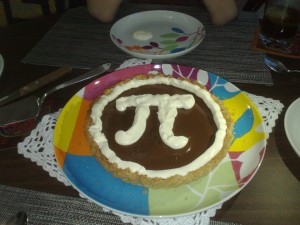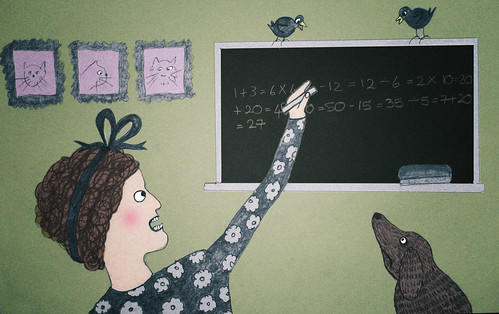Every year on 3.14 (get it?), number enthusiasts celebrate Pi Day (which also happens to be Albert Einstein’s birthday). Pi is “the name of a symbol (π) used in geometry for the ratio of the circumference of a circle to its diameter or 3.1415927,” first used by Swiss mathematician Leonhard Euler in 1748. According to the Online Etymology Dictionary, the word comes from the Greek letter pi (which comes from the Hebrew word for “little mouth”), as an abbreviation of the Greek periphereia, meaning “periphery,” referring to the periphery or diameter of a circle.
(Pi also means “printing-types mixed together indiscriminately; type in a confused or jumbled condition or mass,” but this is probably an alteration of pie, with the idea of a medley or magpie, a bird known for pilfering and hoarding a medley or jumble of objects.)
Piphilology “comprises the creation and use of mnemonic techniques to remember a span of digits of the mathematical constant π.” The word is a blend of pi and philology, “the study of language,” which comes from the Greek philologos, “fond of learning or of words.” A mnemonic (from the Greek mnemonikos, “of or pertaining to memory”) is “a device, such as a formula or rhyme, used as an aid in remembering.”
A piem is such a device for memorizing the digits of pi (if you’re so inclined). A portmanteau of pi and poem, piems “represent π in a way such that the length of each word (in letters) represents a digit.” A famous piem is “How I need a drink, alcoholic of course [or, in nature] after the heavy lectures involving quantum mechanics,” developed by Sir James Jeans, an English physicist, astronomer, and mathematician. For more piems, check out Pi Wordplay from Wolfram Math World.
Another type of mnemonic is a visual mnemonic, which works “by associating an image with characters or objects whose name sounds like the item that has to be memorized.” A simple visual mnemonic for identifying one’s drinking glass and bread plate while dining in a formal setting with others is to form a lower case B with one’s left hand and a lower case D with one’s right. One’s drinking glass, represented by D, is on the right, while one’s bread plate, represented by B, is on the left.
First-letter mnemonics take the first letter of each word of a list of words, and form an acronym, a phrase, or a name. HOMES is an acronym used for memorizing the Great Lakes of North America, consisting of Lakes Huron, Ontario, Michigan, Erie, and Superior. SOHCAHTOA is used for remembering the trigonometric functions “sine equals opposite over hypotenuse; cosine equals adjacent over hypotenuse; tangent equals opposite over adjacent.”
Dear King Philip Come Over For Good Spaghetti is just one of many phrase mnemonics used for memorizing taxonomy in biology (domain, kingdom, phylum, class, order, family, genus, species). A mnemonic for memorizing the planets is My Very Energetic Mother Just Served Us Nine Pizzas (Mercury, Venus, Earth, Mars, Jupiter, Uranus, Neptune, and Pluto), or My Very Educated Mother Just Served Us Nachos, for those anti-planet Pluto. Roy G. Biv is a name mnemonic used for remembering “the color sequence of the visible spectrum” (red, orange, yellow, green, blue, indigo, violet). For even more first-letter mnemonic devices, visit this list – add your own!
Whatever mnemonic device you use, have fun memorizing a million digits of pi!
[Photo via Flickr, CC BY 2.0 by medea_material]


 A few small bits:
A few small bits: